Italy, known for its rich history, culture, and breathtaking landscapes, is also home to some of the largest volcanoes on Earth. These geological giants have left an indelible mark on the country’s terrain. They have also captured the fascination of scientists, adventurers, and nature enthusiasts alike.
The geologic landscape has been shaped by the restless forces beneath the Earth’s crust. The result, the formation of iconic volcanoes that have become both symbols of terror and sources of inspiration.
Among these remarkable geological features, we will delve into the top 10 largest volcanoes, revealing their captivating history and significant impact on the region.
Astonishingly, four of these titans remain active. Their fiery breath reminds us of the ever-present potential for volcanic activity in this captivating country.
Embark on a journey to explore the largest volcanoes in Italy. Witness beauty and danger coexisting in an awe-inspiring display of nature’s power. Discover the stories, mysteries, and geological wonders of Italy’s largest volcanoes. Fine where past eruptions have left their mark, and where future ones could shape the landscape once more.
1. Mount Etna (Sicily)
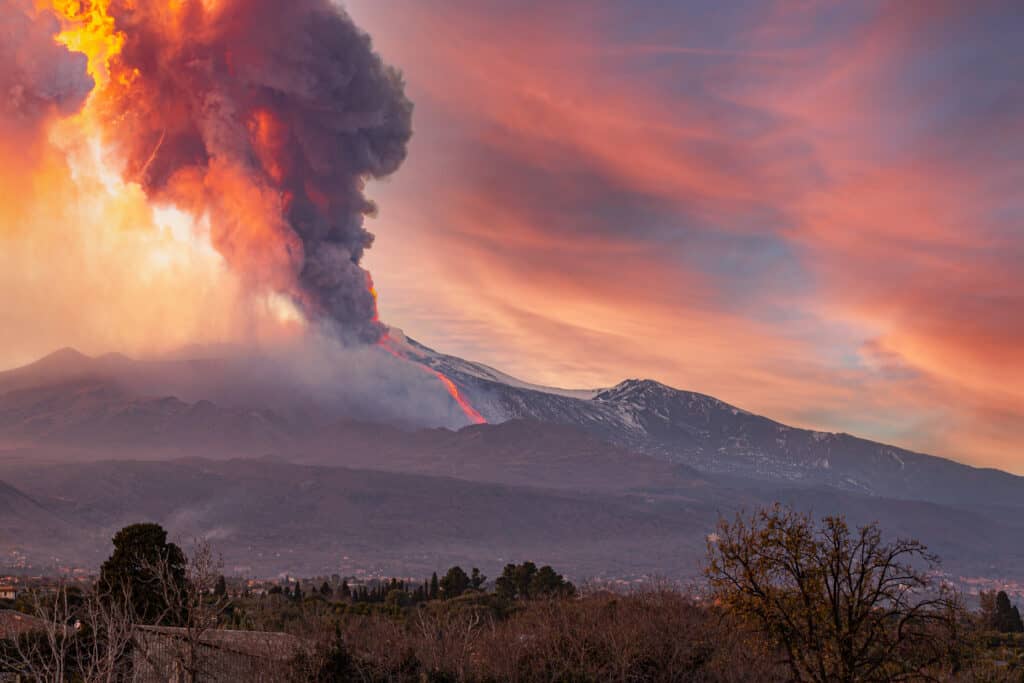
The eruption in 2020 is just one of many for this active volcano.
©Alanstix64/Shutterstock.com
Mount Etna, located on the eastern coast of Sicily, is not only the largest volcano in Italy but also the most active volcano in Europe.
Etna also has a rich history of myth and legend. In Greek mythology, it is often associated with the forge of Hephaestus, the blacksmith of the gods. According to the legend, the cyclopses worked in the heart of Etna, forging Zeus’s thunderbolts. The volcano’s frequent eruptions were believed to be a result of their relentless activity.
Today, Etna continues to be a symbol of both beauty and danger, inspiring awe and reverence in those who witness its eruptions.
It stands at approximately 3,329 meters (10,922 feet) above sea level. The base circumference measures about 140 kilometers (87 miles).
Etna is known for its frequent eruptions, which have been documented for thousands of years. It is characterized by both explosive and effusive eruptions, and its activity often poses a risk to nearby communities.
2. Mount Vesuvius (Campania)
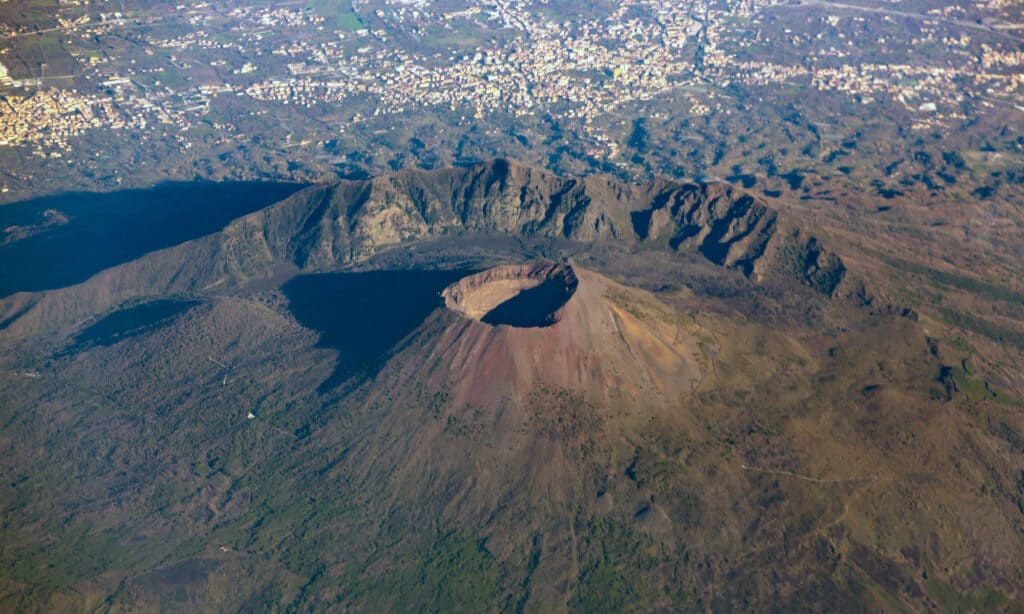
Aerial view of Mount Vesuvius.
©iStock.com/Cylonphoto
Mount Vesuvius is perhaps the most famous Italian volcano due to its devastating eruption in 79 AD. This eruption buried the ancient city of Pompeii and Herculaneum.
This catastrophic event buried these ancient Roman cities under layers of ash and pumice, preserving them in a time capsule until their rediscovery centuries later. The tragic fate of the inhabitants and their possessions serves as a stark reminder of the destructive power of volcanic eruptions.
Located near Naples in the Campania region, Vesuvius is about 1,281 meters (4,203 feet) high.
Although it is currently dormant, Vesuvius is still considered an active volcano. It poses a significant threat to the densely populated area surrounding it. Scientists consider Vesuvius as one of the most dangerous volcanoes on Earth, despite its current dormancy.
3. Stromboli (Aeolian Islands)
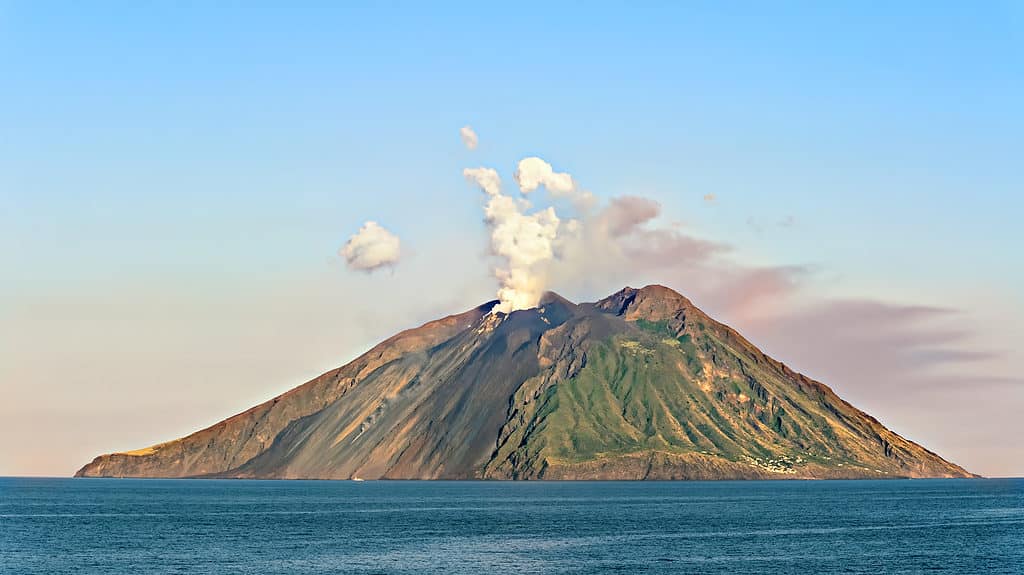
The island Stromboli near Sicily on Tyrrhenian sea. Stromboli is the most active volcanoes in Europe.
©Marek Poplawski/Shutterstock.com
Stromboli is a small volcanic island located in the Tyrrhenian Sea, part of the Aeolian Islands.
It is renowned for its nearly constant volcanic activity, characterized by mild, frequent eruptions that produce spectacular explosions of incandescent material. This history of eruptions goes back at least 2,000 years!
However, it’s also the setting for a lesser-known legend. Local lore tells of a witch who lived on the island, casting a curse that condemned the men of Stromboli to never leave the island, ensuring they would always return. This legend adds an intriguing mystique to the volcano’s fiery displays.
Stromboli’s eruptions have earned it the nickname “Lighthouse of the Mediterranean.” It is about 926 meters (3,038 feet) high.
4. Mount Vesuvius (Sicily)

Volcanic activity frequently results in landslides and destruction of important infrastructure.
©iStock.com/LuckyTD
Located on the island of Sicily, not far from Mount Etna, this volcano is often referred to as “Mount Vesuvius of Sicily” to distinguish it from the more famous Vesuvius near Naples.
Mount Vesuvius in Sicily, also known as Monte Somma, is around 1,132 meters (3,714 feet) high and is part of the Campanian volcanic arc.
It has a complex history of eruptions, with the last major one occurring in 1944. While currently dormant, Somma played an essential part in the formation of the Vesuvius System.
5. Mount Teide
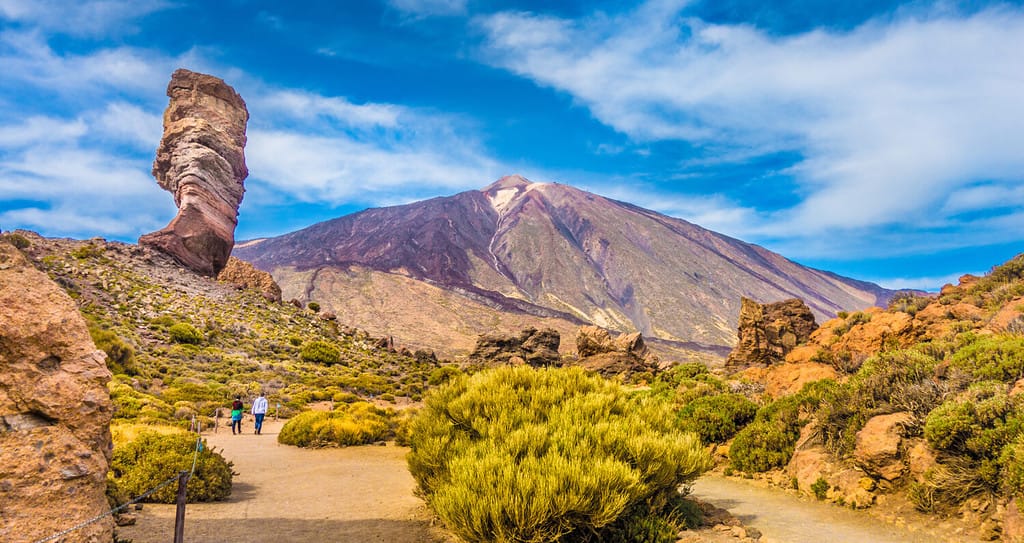
Teide National Park is popular with hikers who enjoy the unique geological formations.
©canadastock/Shutterstock.com
Mount Teide on the island of Tenerife in the Canary Islands is Spain’s highest peak and stands at 3,715 meters.
While not on the Italian mainland, Teide is still considered an Italian volcano.
It’s currently dormant, but its history is marred with powerful eruptions.
Mount Teide last erupted in 1909, and its volcanic soil creates a unique ecosystem.
6. Mount Cimone
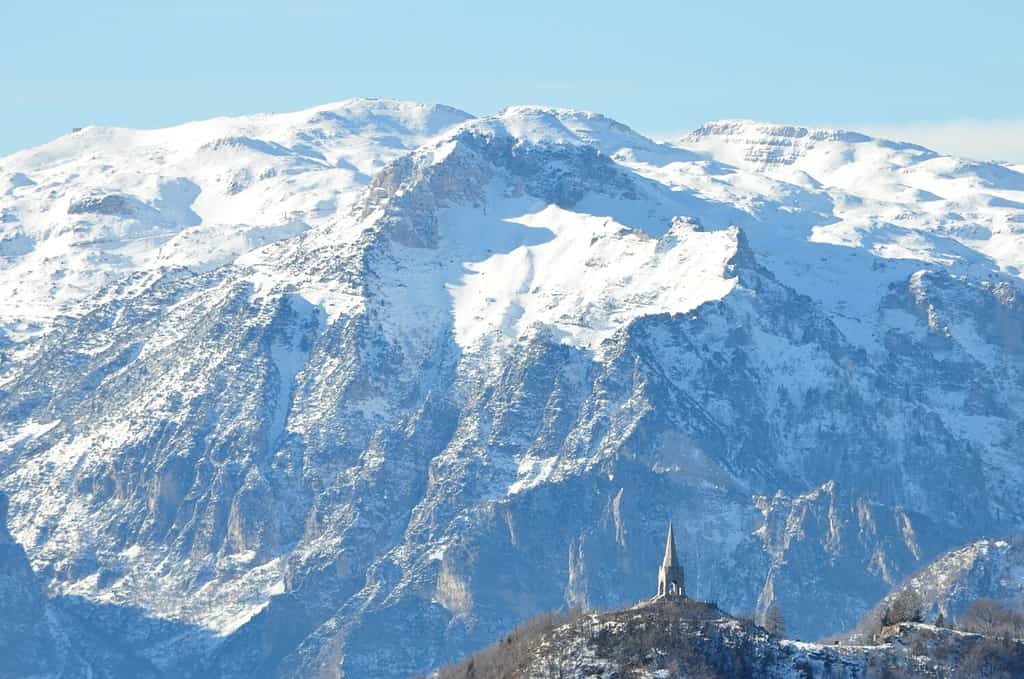
Mount Cimone war memorial with Pasubio in background. Cimone is a popular skiing area.
©Anselmo Pichitterri/Shutterstock.com
Mount Cimone, located in the northern Apennines, reaches 2,165 meters.
It’s situated in the Emilia-Romagna region of northern Italy. Mount Cimone is currently dormant and primarily known for its ski resorts.
Its last eruption occurred over 30,000 years ago. Scientists do not considered Cimone a significant volcanic threat today.
7. Mount Amiata
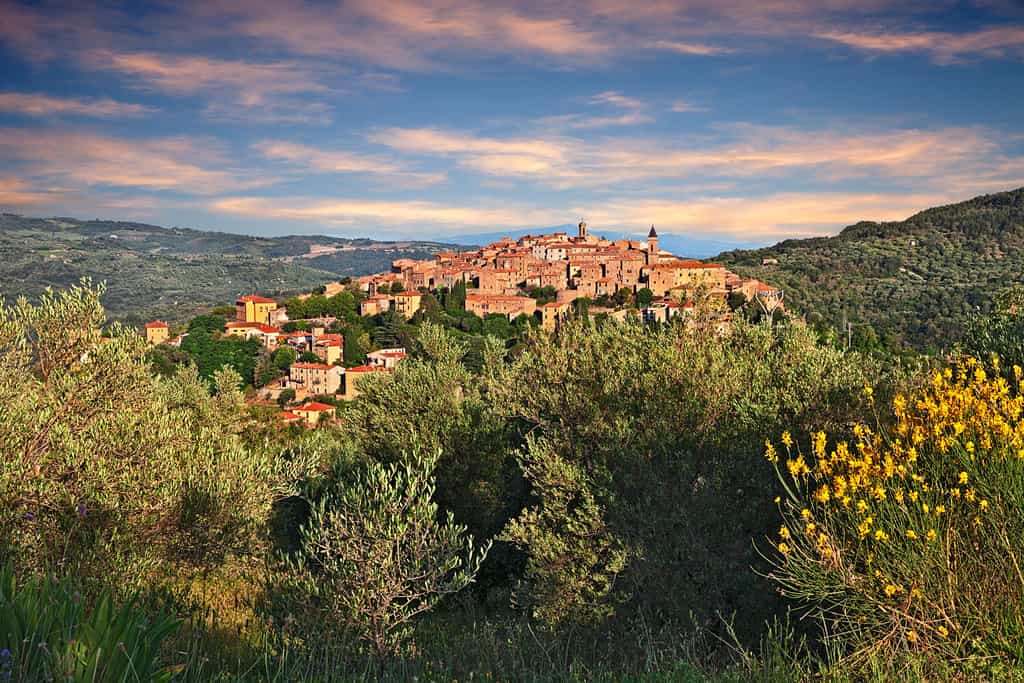
Seggiano, Grosseto, Tuscany, Italy, thrives on the slopes of Mount Amiata.
©ermess/Shutterstock.com
Mount Amiata is 1,738 meters tall and located in Tuscany, part of the Siena province in central Italy.
Currently, Mount Amiata is dormant and serves as a hiking destination for outdoor lovers.
The last eruption occurred approximately 200,000 years ago.
8. Campi Flegrei

Campi Flegrei is a dormant volcano and part of the Phlegraean Fields volcanic area.
©Stefano Tammaro/Shutterstock.com
The Campi Flegrei supervolcano covers a vast area of 13 kilometers across. It lies to the west of Naples, within the Phlegraean Fields.
Campi Flegrei is currently dormant but exhibits signs of volcanic unrest. Scientists regularly monitor Campi Flegrei despite its’ dormant status because of this unrest.
The massive caldera has experienced numerous eruptions, including the famous “Burning Fields” eruption in Roman times.
9. Ischia

Aerial view on Aragonese castle. The castle is the most impressive historical monument in Ischia, build in 474 BC.
©Karel Funda/Shutterstock.com
Ischia is a volcanic island located in the Tyrrhenian Sea west of Naples. The highest point, Mount Epomeo, reaches 789 meters.
While dormant, Ischia is known for its thermal springs and lush landscapes.
The last eruption occurred in 1302, and Ischia is primarily famous for its natural thermal baths.
10. Vulcano
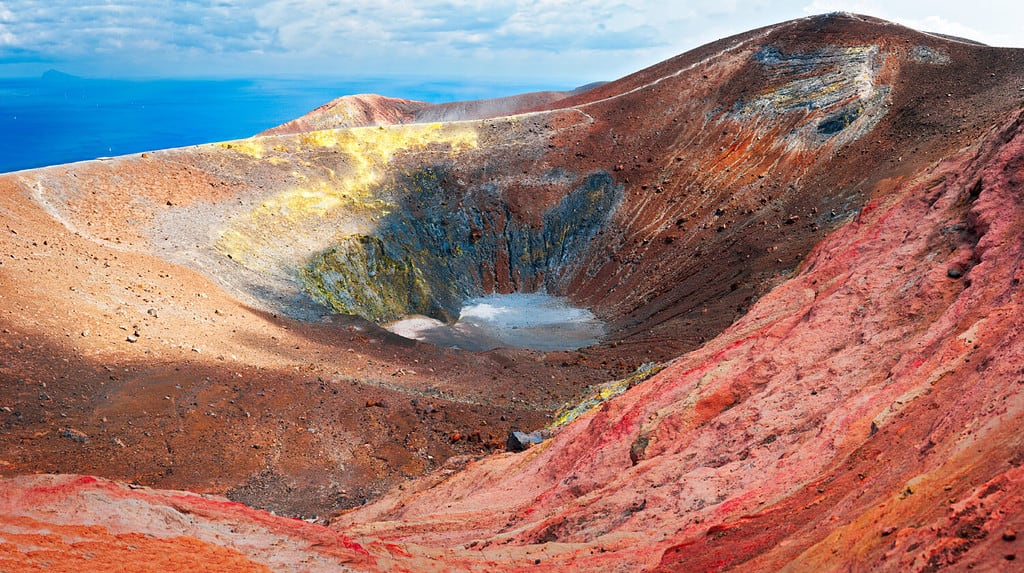
Amazing colorful crater of volcano in Vulcano Island near Sicily.
©easy camera/Shutterstock.com
Vulcano, part of the Aeolian Islands, stands at 501 meters. It’s located in the Tyrrhenian Sea to the north of Sicily.
While relatively quiet as a volcano, Vulcano’s fumaroles and hot springs are still active.
Vulcano last erupted in 1888-1890. Today, Vulcano draws thousands to the area famous for its therapeutic mud baths.
Best Known Italian Volcanoes
| Name | Location | Height (meters) | Status |
| Mount Vesuvius | Campania | 1,281 | Active |
| Mount Etna | Sicily | 3,329 | Active |
| Stromboli | Aeolian Islands, Sicily | 926 | Active |
| Mount Vesuvius | Campi Flegrei, Campania | 458 | Dormant |
| Mount Gran Sasso | Apennines, Abruzzo | 2,912 | Dormant |
| Mount Amiata | Tuscany | 1,738 | Dormant |
| Campi Flegrei | Campania | – | Active |
| Mount Vulture | Basilicata | 1,326 | Dormant |
| Ischia | Campania | 788 | Dormant |
| Mount Cimino | Lazio | 1,053 | Dormant |
Italy’s largest volcanoes are not only breathtaking natural wonders but also reminders of Earth’s power.
Italy’s location along the boundary of the African and Eurasian tectonic plates makes it a seismically active region, leading to the presence of numerous volcanoes, both active and dormant, throughout the country.
While some, like Mount Etna and Stromboli, continue to display their fiery splendor, others, such as Mount Vesuvius and Mount Somma, rest in temporary dormancy.
These mighty mountains serve as a vivid reminder that our planet is alive and ever-changing, with the potential to unleash its fury at any moment. With each eruption, they leave an indelible mark on the Italian landscape, a testament to the fiery forces that shape our world.
The photo featured at the top of this post is © bluejayphoto/iStock via Getty Images
Thank you for reading! Have some feedback for us? Contact the AZ Animals editorial team.







